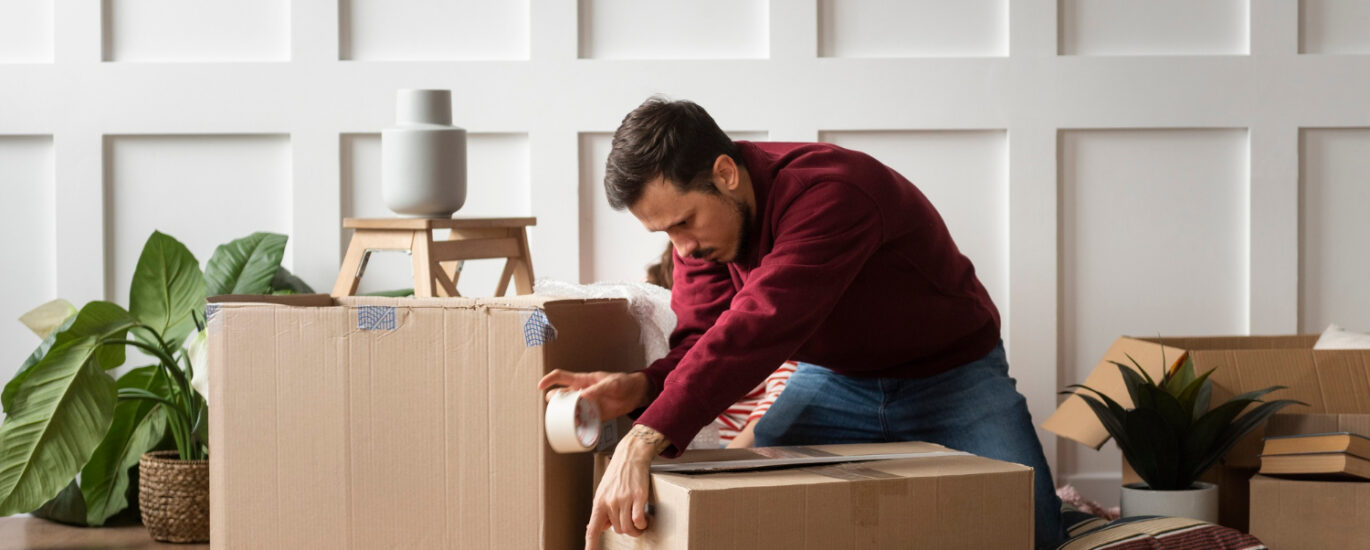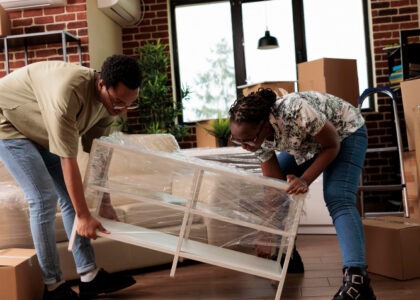Moving homes or offices often involves transporting items that hold both monetary and sentimental value. Fragile items stand out, demanding meticulous attention to ensure their safe transit.
The repercussions of neglecting the proper packing of these delicate treasures can be both emotionally and financially taxing. Damages lead to potential monetary losses and the irreplaceable sentimental value attached to many of these items.
Stride Movers, with its expertise in handling moves, underscores the significance of packing fragile items with the utmost care, ensuring they reach their destination unscathed.
Understanding Fragile Items
Fragile items, often referred to as breakable items or delicate items, are those that can easily break or get damaged due to their intricate design and delicate nature. Recognizing and treating them with the special care they deserve during a move is paramount.
- Glassware: From wine glasses to vases, these items can shatter easily.
- Ceramics and Porcelain: Items like decorative plates or figurines that can crack or chip.
- Electronics: Screens, monitors, and other devices that can be sensitive to jolts.
- Artwork and Mirrors: Canvases, framed pieces, and mirrors that are susceptible to scratches or breaks.
- Antiques and Heirlooms: Often irreplaceable, these items can be both delicate and valuable.
- Light Fixtures: Lamps, chandeliers, and other fixtures that have breakable components.
- Musical Instruments: Especially stringed instruments like violins or guitars that can be sensitive to shocks.
Understanding these items’ nature and vulnerabilities is the first step in ensuring they are packed and transported safely.
Materials Needed for Packing Fragile Items
Each packing material, from packing peanuts to protective material, has its specific purpose and advantage. Understanding how to use these materials, like when choosing paper or bubble wrap, can significantly reduce the risk of damage to fragile items.
- Bubble Wrap: This cushioning material offers a protective layer against shocks. Its air-filled bubbles provide excellent insulation against impacts, making it ideal for wrapping individual fragile items.
- Packing Paper vs. Newspaper: While both can be used for wrapping, packing paper is preferable as it doesn’t leave ink stains. Newspapers, although readily available, can smudge items, especially porcelain or white-colored objects.
- Sturdy Boxes: Choosing the right-sized box is crucial. It prevents items from moving around during transit. Double-walled boxes offer extra protection for particularly delicate items.
- Packing Tape: A strong adhesive is essential to seal boxes securely. It ensures that the box remains closed and provides an added layer of protection against external elements.
- Marker Pens: Clearly labeling boxes as “FRAGILE” or indicating which side should face up can guide movers. It ensures that boxes containing delicate items are handled with extra care and are placed appropriately during transit.
By equipping yourself with these essential packing materials and understanding their proper application, you’re taking a significant step towards ensuring the safety of your fragile belongings during a move.
Read More: Understanding the Costs of Moving in Deerfield Beach
General Packing Tips for Fragile Items
Packing fragile items, especially delicate items like picture frames, requires a combination of the right packing materials, such as bubble wrap and packing tape, and the right techniques. While having quality packing materials is essential, knowing how to use them effectively is equally crucial.
These general packing tips serve as a roadmap to ensure that your delicate items remain intact and unharmed throughout the moving process.
1. Clean and Dry Items
Before you begin packing, it’s vital to ensure that all items are clean and completely dry. Dirt or moisture can lead to damage like mold, staining, or even weaken the structure of certain items. For instance, moisture trapped inside glassware can lead to condensation, which might weaken the glass during temperature fluctuations in transit.
2. Avoid Overpacking
While it might seem like a good idea to fit as much as possible into a single box, overpacking can be detrimental. Too many items in one box can create pressure, leading to cracks or breaks. It’s better to have a bit of extra space filled with cushioning materials than to cram items tightly together.
3. Layering is Key
When placing items in a box, think in layers. Start with a layer of cushioning material at the bottom, place your wrapped items, and then add another layer of cushioning on top. This “sandwich” approach ensures that items are protected from all sides.
4. Ample Padding
Fragile items should never touch each other directly inside a box. Use ample padding between items, like bubble wrap or packing paper, to prevent friction, which can lead to scratches or breaks.
5. Label Clearly
It can’t be stressed enough how important labeling is. It’s essential to label boxes with “FRAGILE” and use special boxes when necessary, alerting everyone handling the box to treat each fragile item with care. Additionally, indicating “THIS SIDE UP” ensures that the box is not turned in a way that might jeopardize the safety of its contents.
6. Seal Boxes Properly
Once you’ve packed a box, ensure it’s sealed securely using quality packing tape. This keeps the contents safe and adds an extra layer of protection against external elements like dust or moisture.
7. Keep Weight in Mind
Even if a box is sturdy, it’s essential to be mindful of its weight. Heavier items should be packed in smaller boxes to make them easier to carry, reducing the risk of dropping. Conversely, lighter fragile items can be packed in larger boxes, provided they’re adequately cushioned.
By adhering to these general packing guidelines, you significantly enhance the safety of your fragile items, ensuring they reach their destination in the same condition they were packed.
Step-by-Step Guide to Packing Specific Fragile Items
To pack fragile items like glasses or vases effectively, fill hollow items with crumpled packing paper or packing peanuts to prevent any empty space inside.
This step-by-step guide dives deep into the best practices for packing various fragile items, ensuring they remain unscathed during the rigours of transit.
1. Glassware and Crystal
- Dividers and Individual Wrapping: Glassware, especially items like wine glasses or champagne flutes, benefit from being separated using cardboard dividers and carefully wrapped in packing paper or bubble wrap. Each piece should be wrapped individually with bubble wrap or packing paper to prevent direct contact and potential breakage.
- Filling Hollow Spaces: This provides internal support and prevents the glass from shattering due to external pressure.
2. Ceramics and Porcelain
- Individual Wrapping: Each ceramic or porcelain item, whether it’s a decorative plate or a figurine, should be wrapped individually using bubble wrap or packing paper. This prevents chipping or cracking during transit.
- Box Placement: Heavier ceramic items should be placed at the bottom of the box, with lighter items on top. This ensures stability and reduces the risk of items being crushed under weight.
3. Electronics
- Original Packaging: Whenever possible, use the original packaging for electronics. These boxes are designed to house the item securely, offering optimal protection.
- Cord Management and Battery Removal: Ensure that all cords are securely tied and stored with the device. Remove batteries from electronic devices to prevent potential leakage or damage during transit.
4. Artwork and Mirrors
- Corner Protectors: The corners of artworks and mirrors are particularly vulnerable. Using corner protectors can prevent chipping or breaking.
- Specialized Wrapping: Wrap artwork and mirrors in bubble wrap, ensuring full coverage. Once wrapped, they should be placed in specialized mirror or picture boxes that offer a snug fit, reducing movement during transit.
5. Antiques and Heirlooms
- Professional Consultation: Given the unique and often irreplaceable nature of antiques and heirlooms, it’s advisable to consult with professional movers for packing recommendations. They can provide insights into the best materials and techniques for specific items.
- Insurance Consideration: Ensure that antiques and heirlooms are adequately insured. This provides an added layer of protection, offering peace of mind during the move.
Stride Movers is the Perfect Choice for Moving And Packing Fragile Items.
When it comes to moving fragile items, the choice of the best moving company plays a pivotal role in determining the safety and integrity of your precious belongings.
With its impeccable track record and specialized expertise, Stride Movers stands out as the go-to choice for those seeking assurance and professionalism in handling their delicate items.
- Experienced Professionals: Stride Movers boasts a team of trained professionals adept at handling fragile items with the care and precision they deserve.
- Tailored Packing Solutions: Understanding that each fragile item is unique, Stride Movers offers customized packing solutions to cater to individual needs.
- State-of-the-Art Equipment: The company employs advanced equipment and tools, ensuring that fragile items are packed, loaded, and transported with utmost safety.
- Comprehensive Insurance: Stride Movers offers comprehensive insurance options, providing clients with peace of mind knowing their valuable items are covered against unforeseen damages.
- Client Testimonials: A plethora of positive reviews and testimonials attest to Stride Movers’ commitment to excellence and client satisfaction.
- Affordable Rates: Despite offering top-notch services, Stride Movers ensures that their pricing remains competitive and transparent, offering great value for money.
- End-to-End Services: From initial consultation to final unpacking, Stride Movers provides a seamless moving experience, ensuring every step is executed with perfection.
Choosing Stride Movers means entrusting your fragile items to a company that values them as much as you do, ensuring they reach their destination in impeccable condition.
Read More: How to Prepare for Movers: A Checklist
Insurance and Fragile Items
The decision to move fragile items, often laden with both monetary and sentimental value, underscores the critical importance of securing appropriate insurance. While the best preventive measures can be taken to ensure the safe transit of these items, unforeseen circumstances such as accidents, extreme weather conditions, or other unpredictable events can pose risks.
Having insurance for fragile items acts as a safety net, offering compensation in the unfortunate event of damage or loss. It provides peace of mind to homeowners, knowing that their cherished belongings have an added layer of protection during the moving process.
Diving deeper into the realm of moving insurance, two primary valuation options emerge full-value protection and released value. Full-value protection, as the name suggests, covers the entire declared value of the item, ensuring that the owner is compensated with a similar item, repairs, or a cash settlement in case of damage or loss.
Unpacking Fragile Items Safely
The journey of fragile items doesn’t end once they reach their destination; the unpacking phase is equally crucial. Just as meticulous care is required when packing these delicate treasures, a strategic approach is essential to ensure their safety and integrity during unpacking.
Here are some pivotal steps to consider when unveiling your fragile items from their protective cocoons:
- Safe Zone: Designate a specific area for unpacking, ensuring it’s free from potential hazards like moisture, sharp objects, or high traffic.
- Stable Surface: Ensure you have a flat and stable surface, like a table or counter, covered with a soft cloth or padding to place items as you unpack.
- Gentle Handling: When opening boxes, use caution. Avoid using sharp objects that might inadvertently damage the contents.
- Check Labels: Always check box labels before unpacking. If it’s marked “FRAGILE” or “THIS SIDE UP,” handle it with extra care.
- Inspect for Damages: As you unpack each item, inspect it for any damages that might have occurred during transit. This will be crucial if you need to file an insurance claim.
- Keep Packing Materials: Until you’re sure all items are intact and undamaged, retain the packing materials. They might be needed if returns or insurance claims are necessary.
- Document Any Issues: If you notice any damages, document them immediately with photos and detailed notes. This will be essential for any potential insurance or mover claims.
Conclusion
The journey of fragile items, from packing to unpacking, is laden with challenges that require meticulous attention and care. The importance of proper packing cannot be overstated, as it not only ensures the physical safety of these items but also preserves their sentimental and monetary value.
While personal efforts can go a long way, sometimes, the expertise of professional services like Stride Movers can make all the difference. Their specialized knowledge and tools can transform a daunting task into a seamless experience.
So, whether you’re taking the DIY route or seeking professional assistance, always prioritize the safety of your valuable items. Ready to make your move stress-free? Contact Stride Movers today!
FAQs
Bubble wrap and packing paper are ideal for glassware, providing cushioning and preventing scratches.
Use original packaging when available, secure cords, and remove batteries to ensure safety.
Absolutely. Labelling boxes as “FRAGILE” and “THIS SIDE UP” alerts movers to handle them with extra care.
Yes, securing insurance provides peace of mind and compensation in case of unforeseen damages.
While it’s eco-friendly to reuse, ensure the box is sturdy and in good condition. If it shows signs of wear, it’s better to use a new box for fragile items.




